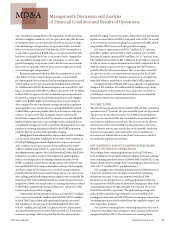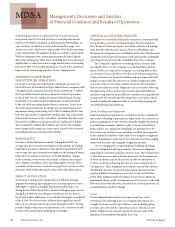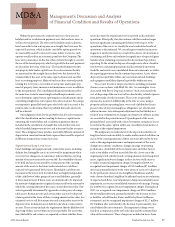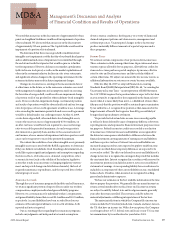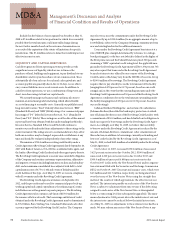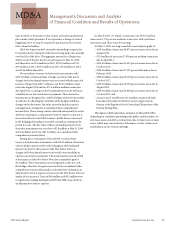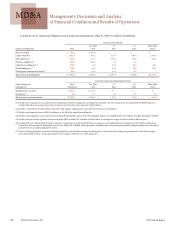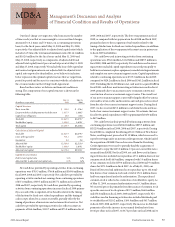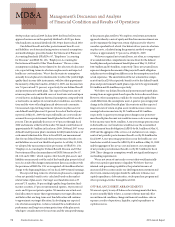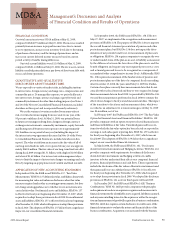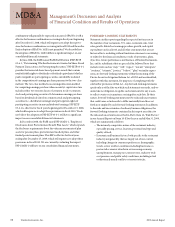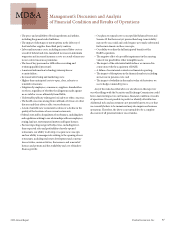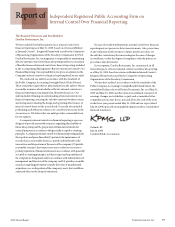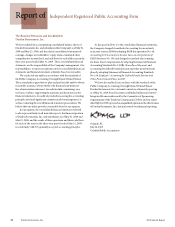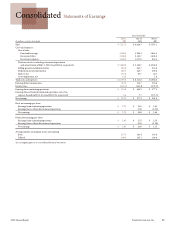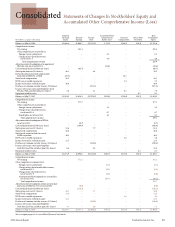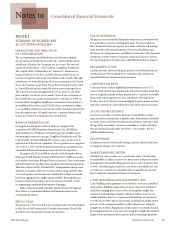Red Lobster 2009 Annual Report Download - page 37
Download and view the complete annual report
Please find page 37 of the 2009 Red Lobster annual report below. You can navigate through the pages in the report by either clicking on the pages listed below, or by using the keyword search tool below to find specific information within the annual report.
MD&A Management’s Discussion and Analysis
of Financial Condition and Results of Operations
2009 Annual Report Darden Restaurants, Inc. 35
FINANCIAL CONDITION
Our total current assets were $554.8 million at May 31, 2009,
compared with $467.9 million at May 25, 2008. The increase resulted
primarily from an increase in prepaid income taxes due to current
year overpayments, an increase in inventory levels due to the timing
of purchases of inventory and the timing of promotions, and an
increase in current deferred income tax assets based on current
period activity of taxable timing differences.
Our total current liabilities were $1.10 billion at May 31, 2009,
compared with $1.14 billion at May 25, 2008. The decrease in current
liabilities resulted primarily from a pay down of short-term debt with
excess cash from operations.
QUANTITATIVE AND QUALITATIVE
DISCLOSURES ABOUT MARKET RISK
We are exposed to a variety of market risks, including fluctuations
in interest rates, foreign currency exchange rates, compensation and
commodity prices. To manage this exposure, we periodically enter
into interest rate, foreign currency exchange, equity forwards and
commodity instruments for other than trading purposes (see Notes 1
and 10 of the Notes to Consolidated Financial Statements, included
elsewhere in this report and incorporated herein by reference).
We use the variance/covariance method to measure value at
risk, over time horizons ranging from one week to one year, at the
95 percent confidence level. At May 31, 2009, our potential losses
in future net earnings resulting from changes in foreign currency
exchange rate instruments, commodity instruments, equity forwards
and floating rate debt interest rate exposures were approximately
$21.9 million over a period of one year (including the impact of
the interest rate swap agreements discussed in Note 10 of the Notes
to Consolidated Financial Statements, included elsewhere in this
report). The value at risk from an increase in the fair value of all of
our long-term fixed rate debt, over a period of one year, was approxi-
mately $149.0 million. The fair value of our long-term fixed rate debt
during fiscal 2009 averaged $1.51 billion, with a high of $1.60 billion
and a low of $1.41 billion. Our interest rate risk management objec-
tive is to limit the impact of interest rate changes on earnings and cash
flows by targeting an appropriate mix of variable and fixed rate debt.
APPLICATION OF NEW ACCOUNTING STANDARDS
In September 2006, the FASB issued SFAS No. 157, “Fair Value
Measurements.” SFAS No. 157 defines fair value, establishes a framework
for measuring fair value and enhances disclosures about fair value
measures required under other accounting pronouncements, but does
not change existing guidance as to whether or not an instrument is
carried at fair value. For financial assets and liabilities, SFAS No. 157
is effective for fiscal years beginning after November 15, 2007, which
required us to adopt these provisions in fiscal 2009. For nonfinancial
assets and liabilities, SFAS No. 157 is effective for fiscal years beginning
after November 15, 2008, which will require us to adopt these provisions
in fiscal 2010. The adoption of SFAS No. 157 did not have a significant
impact on our consolidated financial statements.
In September 2006, the FASB issued SFAS No. 158. Effective
May 27, 2007, we implemented the recognition and measurement
provision of SFAS No. 158. The purpose of SFAS No. 158 is to improve
the overall financial statement presentation of pension and other
postretirement plans, but SFAS No. 158 does not impact the deter-
mination of net periodic benefit cost or measurement of plan assets
or obligations. SFAS No. 158 requires companies to recognize the over
or under funded status of the plan as an asset or liability as measured
by the difference between the fair value of the plan assets and the
benefit obligation and requires any unrecognized prior service costs
and actuarial gains and losses to be recognized as a component of
accumulated other comprehensive income (loss). Additionally, SFAS
No. 158 requires measurement of the funded status of pension and
postretirement plans as of the date of a company’s fiscal year ending
after December 15, 2008, the year ended May 31, 2009 for Darden.
Certain of our plans currently have measurement dates that do not
coincide with our fiscal year end and thus we were required to change
their measurement dates in fiscal 2009. As permitted by SFAS No. 158,
we used the measurements performed in fiscal 2008 to estimate the
effects of our changes to fiscal year end measurement dates. The impact
of the transition to fiscal year end measurement dates, which was
recorded as an adjustment to retained earnings as of May 31, 2009
was $0.6 million, net of tax.
In February 2007, the FASB issued SFAS No. 159 “The Fair Value
Option for Financial Assets and Financial Liabilities.” SFAS No. 159
provides companies with an option to report selected financial assets
and financial liabilities at fair value. Unrealized gains and losses on
items for which the fair value option has been elected are reported in
earnings at each subsequent reporting date. SFAS No. 159 is effective
for fiscal years beginning after November 15, 2007, which was our
fiscal 2009. The adoption of SFAS No. 159 did not have a significant
impact on our consolidated financial statements.
In March 2008, the FASB issued SFAS No. 161, “Disclosures
about Derivative Instruments and Hedging Activities.” SFAS No. 161
provides companies with requirements for enhanced disclosures
about derivative instruments and hedging activities to enable
investors to better understand their effects on a company’s financial
position, financial performance and cash flows. These requirements
include the disclosure of the fair values of derivative instruments and
their gains and losses in a tabular format. SFAS No. 161 is effective
for fiscal years beginning after November 15, 2008, which required
us to adopt these provisions in fiscal 2009. We adopted the disclosure
provisions of SFAS No. 161 as of our third quarter of fiscal 2009.
In December 2007, the FASB issued SFAS No. 141R, “Business
Combinations.” SFAS No. 141R provides companies with principles
and requirements on how an acquirer recognizes and measures in its
financial statements the identifiable assets acquired, liabilities assumed,
and any noncontrolling interest in the acquiree as well as the recogni-
tion and measurement of goodwill acquired in a business combination.
SFAS No. 141R also requires certain disclosures to enable users of the
financial statements to evaluate the nature and financial effects of the
business combination. Acquisition costs associated with the business


